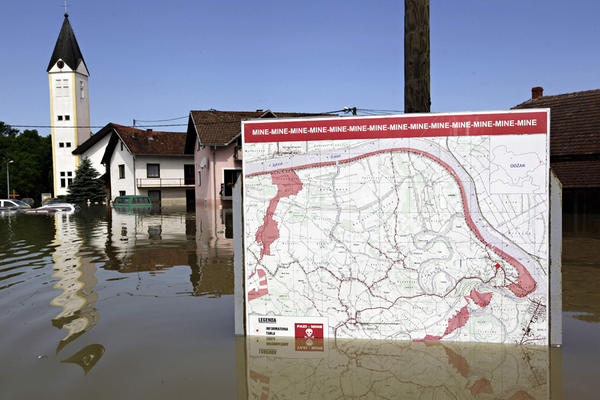May’s deadly floods in Bosnia did more than damage infrastructure. They also shifted land mines, which now pose a very real danger to both residents and recovery teams.
Source: Christian Science Monitor | By: Kristen Chick
◊ In a densely wooded glen miles from the nearest village, a man in protective gear slowly sweeps a metal detector across a tiny section of mud, stopping to probe the ground when the device emits a beep.
Satisfied that there are no land mines in the foot-wide, four-foot-long section, he carefully moves up a red rod that marks the cleared territory, and begins his careful sweep all over again on the next section.
This valley marked the boundary between Serb and Bosniak Muslim forces during the civil war, and the hillside was sown with mines. But May’s devastating floods and landslides in Bosnia have displaced an untold number of the deadly devices from their known fields throughout northeast Bosnia, posing a very real danger to both residents and recovery teams.
So now in some areas, like Sapna, minesweepers are undertaking the painstaking, inch-by-inch process to clear fields before workers can move in to repair the flood damage – in this case, a water system that delivers drinking water to nearby villages. Yet one and a half months after the floods, the extent of the problem is still unclear and the recovery is just beginning.
Most mined country in Europe
The floods inundated parts of northeast Bosnia, killing 21 people (with two still missing), destroying more than 100,000 buildings, and causing an estimated $2.7 billion in damage.
But complicating recovery efforts, 70 percent of the flood-affected zones were in areas contaminated by mines, according to the United Nations Development Programme (UNDP).
Nearly two decades after the civil war here ended, Bosnia is still the most mined country in Europe; more than 600 people have died from the explosive devices since the war ended in 1995. Bosnia pledged to finish de-mining efforts by 2019, but even before the floods, that was looking increasingly unlikely. There are still more than 1,200 square kilometers left of mine-suspected areas, and the average clearance rate is only 13 square kilometers per year, according to the government’s Mine Action Center.
Now, the floods have made the cleanup even slower. To determine where mines may have shifted in order to mark the new dangerous areas, officials must conduct a comprehensive survey that will likely take three to six months. Jasmin Porobic, who oversees the UNDP’s explosive ordnance destruction project in Bosnia, says the floods and landslides have pushed back Bosnia’s de-mining process by 12 to 18 months.
At least 92 mines have so far been recovered following the floods, along with more than 40,000 munition or unexploded ordnance pieces. Two flood-displaced mines have so far exploded. No one was injured, but officials fear that could change. Mr. Porobic says the disaster has kept people from activities like mushroom hunting or illegal logging that for many are their only source of income. If those activities take them into newly mined areas, “once people go back to their routines, we may see more victims,” he says.
UNDP and other organizations have conducted emergency awareness campaigns to warn people of the danger, and billboards urging caution line the roads in affected areas. Teams like the one in Sapna have conducted emergency clearance efforts in areas where landslides damaged infrastructure like roads or water systems.
But uncovering the real scope of the problem will take much longer. Officials are cautious when talking about new areas suspected of being mine-contaminated, because once an area is designated as such, it takes intense – and expensive – effort to declare an area cleared.
‘Very risky’
Back in the Sapna area, the de-mining team, funded by UNDP, found three anti-personnel mines in more than a week of work, says team leader Mustafa Mesic.
Before they could even begin de-mining, teams had to clear the road to the site, which was blocked by multiple landslides. It now takes nearly an hour of bouncing along the heavily rutted track in a four-wheel-drive vehicle, passing areas where the edge of the road has fallen away in a landslide, to reach the site where the team is working.
The de-mining itself is also difficult. Because the area is hilly and wooded, it must be done with metal detectors instead of faster machinery. Mud from the landslide in the valley is in some places up to 16 feet deep, says Mr. Mesic, while the metal detector only works to a depth of about one and a half feet. So the team must clear the area layer by layer, removing half a meter of mud after making sure it is clear of mines, and then beginning all over again.
Until the team completes its work and others repair the water line, residents from some nearby towns will be without clean water. Sabaheta Muhanovic, who lives in the nearby town of Handzelic, says her family can now use the water from the faucet for washing dishes and bathing. In the first days after the floods, it was so dirty that it was entirely unusable.
Though the water now appears cleaner, authorities warn it is still not safe to drink. Buying bottled water for drinking has become a financial burden on her family, Ms. Muhanovic says. Her family has a reservoir at their home, but that water isn’t safe to drink either.
“Some people from these villages are risking drinking from their reservoirs,” she says, “but it’s very risky.”
◊ Original article: http://bit.ly/1qyCxUb
July 5, 2014








